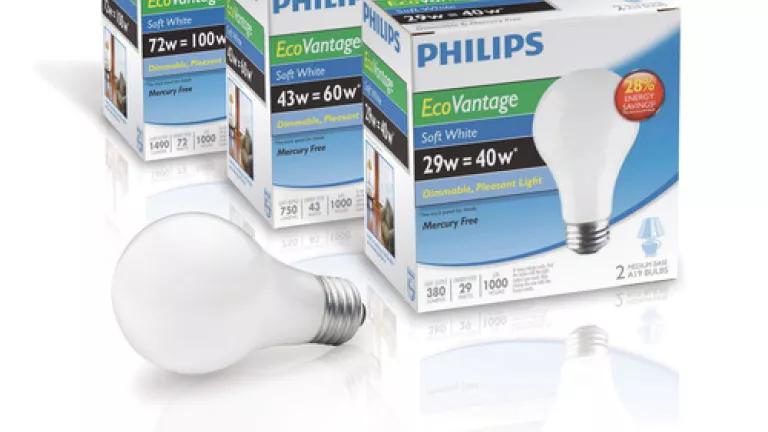Screwing Around with Efficiency: Congress' Cheap Light Bulb Stunt Could Be Costly for Consumers, Jobs and the Clean Energy Economy

The $1.1 trillion-dollar budget bill just passed by Congress will avoid a government shutdown and fund the government until October, but it includes a couple of screwed-up provisions – called “riders” -- as concessions to conservative House members. One affects light bulb energy savings, of all things.
This light bulb rider says that the U.S. Department of Energy cannot spend any money to enforce or implement energy efficiency standards for light bulbs. On one level, this is just a cheap political stunt. After all, the energy efficiency standards for lighting (which George W. Bush signed into law in 2007) are still in place and are being phased in as planned. And U.S. manufacturers support energy efficiency and still plan to comply with the law by moving forward to offer an expanding range of ever more thrifty bulbs, including the squiggly CFLs, super-efficient LED bulbs, and new types of efficient incandescent bulbs. By the way, the efficient incandescent bulbs look just the same as the old-style bulbs (as this photo shows), produce just the same light and use almost 30% less electricity.
But this light bulb “rider” is still bad energy policy. It could open the door for foreign manufacturers to undercut U.S. companies by selling substandard old-style bulbs, which don’t meet U.S. standards for saving energy. This will hurt U.S. companies that are making the more efficient lights and result in smaller energy savings for all of us. And it will also cost American jobs. The rider needs to be removed so government can do its job and protect U.S.
Efficient bulbs save Americans money
News flash to Congress: energy efficiency saves money by reducing electricity bills. While more efficient bulbs cost more at the store register, they are money savers winners over all. With a shift to more efficient bulbs, consumers can save $100 a year on their household electricity bills and the country can save enough electricity each year to feed all the homes in Texas. These savings add up to $10 billion nationally, when fully implemented. That’s $10 billion that will be injected right back into the economy, where it can help U.S. businesses grow and create jobs instead of being wasted because of inefficiency. We’ll also further reduce energy demand and power plant pollution by avoiding the need for 30 large fossil fuel power plants.
NRDC’s handy lighting guide shows all the new light bulb options and how much they save:

American jobs at stake
U.S. lighting manufacturers are creating American jobs to meet the new demand for efficient lighting right here in the United States, in states like Ohio and North Carolina. There are thousands of new American jobs in manufacturing, research, development, design and marketing of new lighting options. In fact, at least one American manufacturer has even moved some of its operations back to the U.S. from China to meet demand for the new, more efficient bulbs. How often do we see that happen?
But the bulb rider opens the door for foreign manufacturers to sell substandard bulbs in the United States and undercut U.S. companies who are complying with the energy-saving standards. "Given that American manufacturers have committed to following the law regardless of whether or not it is enforced," Ohio Congresswoman Marcy Kaptur explained on the House floor during a debate over a similar light bulb rider last summer, "the only benefit of this ill-informed rider is to allow foreign manufacturers —who may not feel a similar obligation—to import noncompliant light bulbs that will not only harm the investments made by U.S. companies, but place at risk the U.S. manufacturing jobs associated with making compliant bulbs."
A marketplace and a policy decision
Moving forward, there are two ways for energy-wise consumers to make their voices heard, at the checkout counter and in Congress. When you go to the store, look for and buy the most money-saving, efficient light bulbs that work for you. Bulbs with the ENERGY STAR® label on the package ensure the highest quality. The other step is to tell Congress to stop screwing around on light bulb efficiency. Let’s get rid of the light bulb rider the next time we can. Congress could – and should – eliminate it as they begin working on the next spending bill for government after October. The rider is a cheap stunt that could cost Americans money. It’s not right. Let’s move forward on energy efficiency, not backward.

